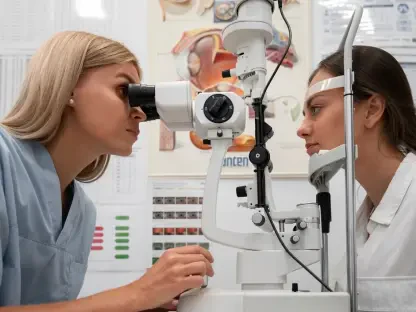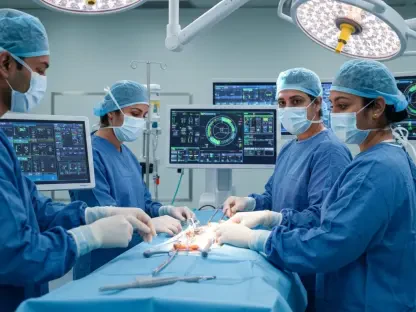In the ever-evolving landscape of medical technology, robotic surgery systems stand out as a transformative force, redefining the precision and safety of surgical procedures across the globe. Consider the staggering reality that millions of surgeries each year now benefit from robotic assistance, slashing recovery times and minimizing complications in ways traditional methods could not achieve. This remarkable shift prompts a deeper exploration into how these advanced systems are reshaping health care, from intricate cardiovascular operations to routine minimally invasive procedures. This review delves into the core of robotic surgery technology, examining its evolution, current capabilities, and the profound impact it has on patient outcomes and medical practice.
Introduction to Robotic Surgery Systems
Robotic surgery systems represent a groundbreaking integration of robotics, computer assistance, and minimally invasive techniques, enabling surgeons to perform complex operations with unprecedented accuracy. These platforms typically consist of robotic arms controlled by a surgeon through a console, offering enhanced dexterity and eliminating natural hand tremors. The technology allows for smaller incisions, reducing trauma to the body and leading to faster healing for patients. Such advancements have positioned robotic surgery as a cornerstone of modern medical practice, fundamentally altering the approach to surgical care.
The journey of robotic surgery began with early prototypes in the late 20th century, progressing to sophisticated platforms widely adopted in hospitals today. Over recent decades, systems like the da Vinci Surgical System have become synonymous with precision, gaining traction in specialties ranging from urology to gynecology. The global adoption rate continues to climb, with thousands of hospitals integrating these tools to meet the rising demand for safer, less invasive options. This historical progression underscores a broader trend in health care toward leveraging technology for better outcomes.
Beyond technical innovation, the relevance of robotic surgery lies in its tangible benefits to patients and medical professionals alike. Reduced recovery times mean shorter hospital stays, while improved surgical accuracy lowers the risk of complications. Additionally, these systems empower surgeons to tackle procedures that were once deemed too risky or complex. As a pivotal element of the medical technology landscape, robotic surgery not only enhances clinical results but also sets a new standard for what is possible in health care delivery.
Core Components and Technologies of Robotic Surgery Systems
Surgical Robot Arms and Precision Tools
At the heart of robotic surgery systems are the surgical robot arms, engineered to replicate and surpass human hand movements with remarkable precision. These arms are equipped with specialized tools that can rotate and pivot in ways a human wrist cannot, offering multiple degrees of freedom for intricate tasks. By filtering out hand tremors, they ensure steady, controlled movements, which are critical in delicate operations such as cardiac or oncologic surgeries where even a slight error can have significant consequences.
The performance of these robotic arms is a game-changer in complex surgical environments. Their ability to execute minute maneuvers allows for procedures in tight anatomical spaces, often inaccessible through traditional methods. For instance, in cardiovascular surgeries, the precision tools can navigate around critical structures with minimal disruption, enhancing both safety and efficacy. This level of dexterity redefines surgical possibilities, pushing the boundaries of what can be achieved in the operating room.
Moreover, the significance of these tools extends to their adaptability across various surgical specialties. Whether performing a prostatectomy or a hysterectomy, the robotic arms can be customized with different instruments tailored to specific needs. This versatility ensures that the technology remains relevant across diverse medical fields, providing a scalable solution for hospitals aiming to improve their surgical offerings. The impact of such precision on patient outcomes continues to drive investment in these systems worldwide.
Imaging and Visualization Systems
Complementing the mechanical prowess of robotic arms are the advanced imaging and visualization systems integral to robotic surgery platforms. High-definition 3D visualization provides surgeons with an immersive view of the surgical site, magnifying details far beyond the capabilities of the naked eye. This enhanced perspective is crucial for identifying critical structures and navigating complex anatomies during operations, thereby elevating situational awareness to new heights.
Real-time imaging further amplifies the effectiveness of these systems by offering dynamic feedback throughout a procedure. Surgeons can make informed decisions on the spot, adjusting their approach as conditions evolve within the patient’s body. For example, during abdominal surgeries, real-time visuals help in avoiding unintended damage to surrounding tissues, directly contributing to improved safety profiles. This capability transforms the operating theater into a space of heightened control and responsiveness.
The integration of such imaging technologies also fosters greater collaboration among surgical teams. With shared, high-quality visuals accessible through the system’s console, multiple specialists can provide input during critical moments, ensuring a cohesive strategy. This collaborative aspect, combined with the clarity of 3D imaging, minimizes errors and enhances overall procedural success. As a result, patient safety receives a significant boost, reinforcing the value of visualization in modern surgical practice.
Recent Innovations in Robotic Surgery
The field of robotic surgery is witnessing a surge of innovations, with artificial intelligence (AI) playing a pivotal role in enhancing system capabilities. AI-driven predictive assistance now aids surgeons by analyzing data in real time, offering insights into potential complications before they arise. This technology, increasingly embedded in surgical platforms, allows for proactive adjustments during operations, marking a significant leap forward in procedural intelligence and patient care.
Emerging trends also point to the development of smaller, more portable robotic systems designed for flexibility in diverse hospital settings. These compact units aim to bring advanced surgical options to facilities with limited space or resources, broadening access to cutting-edge care. Additionally, the incorporation of machine learning enables personalized surgical approaches, tailoring procedures to individual patient anatomies and conditions, thus optimizing outcomes on a case-by-case basis.
Industry behavior reflects a growing commitment to these advancements, with hospitals ramping up investments in robotic surgery infrastructure. Collaborations between medical institutions and technology companies are accelerating the pace of innovation, driving the creation of next-generation systems. From 2025 to 2027, projections suggest an even steeper rise in such partnerships, as stakeholders aim to integrate more sophisticated AI and automation features, further solidifying robotic surgery’s place in mainstream health care.
Applications and Real-World Impact
Robotic surgery systems have found diverse applications across numerous medical specialties, transforming how surgeries are performed in cardiovascular, urologic, gynecologic, and abdominal fields. These systems excel in minimally invasive procedures, allowing for precise interventions with reduced physical impact on patients. Their ability to handle a wide range of operations has made them indispensable in modern hospitals striving for superior clinical results.
A notable example of real-world implementation is the use of Mantra robots in Colombian hospitals, where they have been deployed for intricate cardiovascular and oncologic surgeries. These systems have demonstrated exceptional precision, significantly cutting down recovery periods and improving patient satisfaction. Such implementations highlight the practical benefits of robotic technology, showcasing its capacity to elevate standards of care in specific regional contexts.
Unique use cases, such as remote surgeries facilitated by robotic systems, underscore their potential to bridge geographical gaps in health care access. By enabling specialists to operate on patients in underserved or rural areas via telecommunication links, these systems promise to democratize specialized medical services. This capability could redefine health equity, ensuring that advanced surgical care reaches populations previously out of reach, thus reshaping global health care dynamics.
Challenges and Limitations in Adoption
Despite their transformative potential, robotic surgery systems face significant technical challenges that hinder widespread adoption. The high cost of acquiring and maintaining these platforms remains a primary barrier, often placing them beyond the financial reach of smaller hospitals or those in low-resource settings. This economic constraint limits the technology’s scalability, creating disparities in access to advanced surgical care across different regions.
Regulatory hurdles also pose substantial obstacles, as approval processes and safety standards differ widely by country and can delay implementation. Ensuring compliance with stringent guidelines requires time and resources, often slowing the integration of new systems into clinical practice. These variations in oversight complicate efforts to standardize robotic surgery adoption on a global scale, necessitating tailored strategies for each market.
Market challenges further compound the issue, particularly in terms of accessibility and training. Equipping medical staff with the skills to operate these complex systems demands extensive, ongoing education programs, which can strain hospital budgets. Efforts to develop cost-effective solutions and scalable training initiatives are underway, but progress remains uneven. Addressing these limitations is crucial for ensuring that the benefits of robotic surgery extend to a broader population without exacerbating existing health care inequalities.
Future Prospects of Robotic Surgery Systems
Looking ahead, the trajectory of robotic surgery systems points toward groundbreaking advancements, particularly in AI-driven automation and haptic feedback technologies. Enhanced AI could enable greater autonomy in routine surgical tasks, allowing surgeons to focus on critical decision-making while the system handles repetitive actions. Haptic feedback, meanwhile, promises to provide tactile sensations through the console, giving surgeons a more intuitive sense of tissue resistance and improving control during delicate procedures.
Broader accessibility also looms on the horizon, with ongoing efforts to reduce costs and design compact systems suitable for smaller hospitals. Innovations aimed at streamlining manufacturing processes and modular designs could lower price points, making robotic surgery viable for a wider range of health care facilities. Such developments would democratize access, ensuring that more patients benefit from cutting-edge surgical interventions regardless of their location or economic status.
The long-term impact on health care could be profound, with robotic surgery poised to redefine surgical standards globally. Improved patient outcomes, driven by precision and safety enhancements, may become the norm rather than the exception. As these systems integrate further with other digital health technologies, they hold the potential to create a more connected, efficient health care ecosystem, ultimately transforming how surgeries are planned, executed, and evaluated on a worldwide scale.
Conclusion and Overall Assessment
Reflecting on the exploration of robotic surgery systems, it becomes evident that their role in enhancing precision, safety, and efficiency in medical procedures is nothing short of revolutionary. These technologies demonstrate a capacity to transform patient care through minimized recovery times and reduced surgical risks, setting a high benchmark for clinical excellence. Their integration into various specialties showcases versatility and effectiveness, proving their value in diverse medical contexts.
Yet, the journey reveals persistent challenges, notably in cost and accessibility, which temper the pace of global adoption. Technical and regulatory barriers also underscore the need for strategic solutions to ensure equitable distribution of these benefits. Despite these hurdles, the innovations in AI and system design highlight a path toward overcoming such limitations, painting a hopeful picture for broader implementation.
Moving forward, stakeholders need to prioritize collaborative efforts between technology developers and health care providers to drive down costs and enhance training programs. Investment in scalable, user-friendly systems could accelerate adoption in underserved regions, addressing disparities in access. Additionally, policymakers must streamline regulatory frameworks to facilitate faster, safer integration of new advancements. By focusing on these actionable steps, the health care industry can ensure that robotic surgery’s transformative potential reaches every corner of the globe, paving the way for a future where advanced care is a universal standard.









